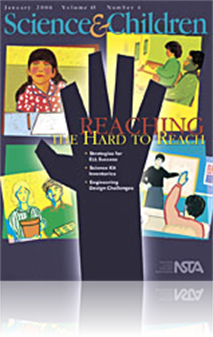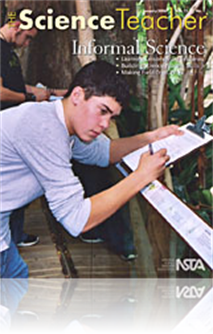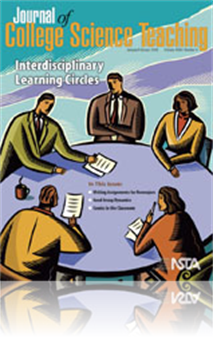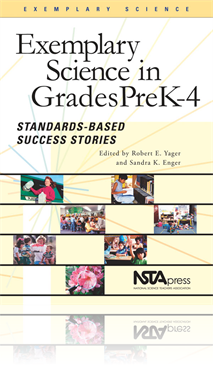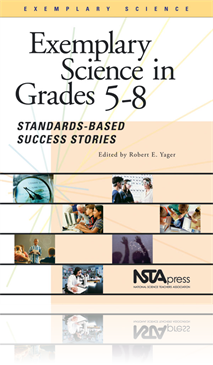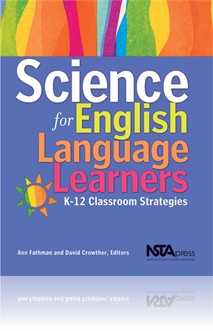All Resources
Journal Article
Design Challenges Are "ELL-ementary"
Engineering activities encourage English Language Learners to express understanding through language and actions. This article describes one school’s experience with the Museum of Science (Boston) program Engineering is Elementary and provides a mo...
Journal Article
Building Science Process Skills
A well-designed and executed field trip experience serves not only to enrich and supplement course content, but also creates opportunities to build basic science process skills. This article describes an onsite trip to the Bronx Zoo that allowed coll...
Journal Article
Scope on the Skies: Location, location, location
While traveling from home to distant locations, it is easy to feel both a sense of unfamiliarity as well as familiarity with the change in location, especially when considering the view of day and night skies. The position of celestial objects like t...
Journal Article
Society for College Science Teachers: What Currency Should We Use?
A colleague's favorite question when the issue of evaluationg teaching arises is to ask, "What's the currency?" In this article, we discover the various quandries involved in quantifying quality teaching. ...
Journal Article
Editorial: So, Where's the Guy with the Cape?
In this section the new editor of the Journal of College Science Teaching, Ann Cutler introduces herself and dispels some of the myths about being an editor. She offers insight into her life as a prodigal academics' daughter and offers her own perso...
Journal Article
Science Sampler: Fired up about science
Turn the "wow" factor into the "how" factor with this exciting activity that reinforces or introduces the skills of observing and inferring with the use of flash paper and candles. The magic of this lesson is that the flash of combustion ignites inqu...
Journal Article
Idea Bank: A Sense of Place--GPS and the Biology Field Trip
In this month's Idea Bank column, a high school biology teacher describes an inquiry-based, high-tech scavenger hunt based on a hybrid form of geocaching that he developed called "BioCache," where students explore the wonders of nature and biology us...
Journal Article
Science Sampler: Developing the scientist in your students
Develop the budding scientist within your students by weaving this hands-on, exciting project into your science curriculum. This inquiry-based project allows students to design, carry out, annalyze, and communicate their findings to their peers while...
Book Chapter
Building on the Natural Wonder Inherent in Us All
The Gladbrook-Reinbeck School District is located in Iowa, a state of just over three million people. The rich farmland that surrounds the district produces corn, beans, cattle, swine, and proud hardworking people. Naturally, many of the businesses ...
Book Chapter
Teaching Science With Student Thinking in Mind
This chapter describes the Discover Lab Concept (DLC), a project that began in a teaching/learning laboratory at Stony Brook University, and today is a foundation of science instruction in classrooms on Long Island and regions beyond. The chapter des...
Book Chapter
Unlocking the National Science Education Standards With IMaST
The National Science Foundation funded the IMaST project for three consecutive developmental cycles to design an integrated middle school curriculum. As a developmental research project, the IMaST developed 16 standards-based curriculum modules that ...
Book Chapter
Achieving a Vision of Inquiry: Rigorous, Engaging Curriculum and Instruction
The changing emphases of the National Science Education Standards (NSES) have spurred many school districts to reinvent their science programs. New curricula development by National Science Foundation-funded programs have been at the core of some dis...
Book Chapter
Adapting the JASON Project: Real Science, Real Time, Real Learning
The JASON Project is a multidisciplinary curriculum involving real science studies and comparing them to local studies performed by students. The Plymouth Public School System, located on the south shore of Massachusetts, adopted the JASON Project as...
Book Chapter
"Re-Inventing" Science Instruction: Inquiry-Based Instruction in a Fifth/Sixth-Grade Classroom
The author's purpose in sharing her experiences in this monograph is to help other teachers who may be less confident in teaching science than they are teaching other subjects, to help them see the value in what the Standards envision for students, a...
Book Chapter
What Do We Get to Do Today? The Middle School Full Option Science System Program
This chapter presents the Full Option Science System (FOSS) and the features that address the four National Science Education Standards (NSES). With FOSS curriculum students are introduced to content through exploration of and asking questions about ...
Book Chapter
ARIES: Science as Discovery . . . and Discovery as Science!
This chapter presents Project ARIES, developed at the Harvard-Smithsonian Center for Astrophysics and funded by the National Science Foundation, with additional support from Harvard University and the Smithsonian Institution. ARIES is a modular, astr...
Book Chapter
The 15 previous stories give evidence of the Standards' impact, along with important examples for others for improvements they might consider if they want to move in directions like those advanced by the persons involved in preparing the Standards. A...
Book Chapter
In light of the increasing emphasis placed on the importance of teachers and their actions and the reality that we have an inadequate pool of qualified science and mathematics teachers to meet our needs, many reform efforts and funding initiatives fo...
Book Chapter
Teaching Science With Pictures
The state of Texas is divided into 20 Regional Education Service Centers (ESC). Schools located in three of the independent school districts of the largest region—Region IV ESC—were selected as pilot sites for a program designed to increase stude...
Book Chapter
Finding Out What...and How They Know
The setting for this chapter is Hawkins Middle School located in a small rural city, the county seat of one of the poorest counties in Wisconsin. In this project students engaged in a learning experience that was integrated across subject areas and f...
Book Chapter
The reader may question how the "Teach them to fish" proverb relates to science education. Yet, a shift in emphasis from presenting knowledge through lecture and demonstration to encouraging active learning, in which students learn with understanding...
Book Chapter
Creating a Classroom Culture of Scientific Practices
Scientific practices are the activities that scientists engage in as they investigate the natural world. These daily practices include asking questions, designing investigations, finding, incorporating, and using information, collecting and organizin...
Book Chapter
More Emphasis on Scientific Explanation: Developing Conceptual Understanding and Science Literacy
This chapter describes a process for engaging middle school students in writing scientific explanations in the context of project-based science. In four Detroit classrooms, teachers enacted strategies for explanation writing that aimed to help studen...
Book Chapter
Traveling the Inquiry Continuum: Learning Through Teacher Action Research
This chapter addresses the More Emphasis on Teaching and the Content and Inquiry Standards from the National Science Education Standards (NSES). Using the knowledge gained through the Community of Excellence in Mathematics and Science (CEMS) program,...
Book Chapter
Modeling: Naturally Selecting an Effective Teaching Method
This chapter examines middle school level curriculum for evolution which incorporates many aspects of the More Emphasis conditions from the National Science Education Standards (NSES). Taking into account that in order to teach evolution successfully...
Book Chapter
Teaching English Through Science and Science Through English
What better way to learn English than through the study of science, and what better way to learn about science than experiencing it through language and literacy in and out of the classroom. Sutman, Allen, and Shoemaker (1986) observed in Learning E...
Book Chapter
Perspectives on Teaching and Integrating English as a Second Language and Science
In the chapter, the authors briefly review the evolution of ESL instruction and science education. They discuss current promising practices that integrate ESL, literacy, and science. Finally, they highlight innovative programs in schools that offer i...



